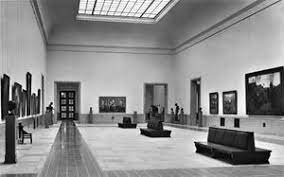Onze beoogde minister-president wil bijna alle cultuursubsidies afschaffen. Alleen kunst die goed te begrijpen valt door ‘echte Nederlanders’ verdient nog financiële steun. Wilders richt zich op cultuursubsidies vanuit een ideologische achtergrond. Wie de tentoonstelling ‘Kunst in het Derde Rijk – Verleiding en afleiding’ in Museum Arnhem bezoekt, ontkomt er niet aan verontrustende vergelijkingen te zien.
Wilders ziet kunst als een instrument om de Hollandse identiteit te versterken. Het maakt onderdeel uit van zijn rechts-radicale gedachtegoed. Vanzelfsprekend is Wilders geen Hitler, maar hun opvattingen over kunst komen als twee druppels water overeen. Hitler zette de kunst ideologisch in voor zijn nationaalsocialistische gedachtegoed, zo blijkt in Museum Arnhem.
De expositie ‘Kunst in het Derde Rijk – Verleiding en Afleiding’ laat zo’n negentig propagandistische kunstwerken zien van ongeveer zestig kunstenaars. Ze zijn onderverdeeld in de thema’s ‘volk en platteland’, ‘industriële ontwikkeling’, ‘lichaamscultuur’ en ‘militaire propaganda’. De tentoonstelling is omstreden: moet je in deze gepolariseerde tijd waarin extreem rechts zo nadrukkelijk aanwezig is, zulke kunst laten zien? Persoonlijk lijkt me dit geen enkel probleem. De tentoongestelde kunstwerken missen elke overtuigingskracht, zodat ik me niet kan voorstellen dat iemand daardoor op ‘bruine’ ideeën komt.
Tijdens mijn bezoek was het er razend druk met allemaal nette mensen die – gok ik – keurig GroenLinks hebben gestemd. Waarschijnlijk liepen ze verbijsterd rond met dezelfde vraag in het achterhoofd: hoe kan het dat zulke voor een groot gedeelte oppervlakkige kunst zo’n belangrijk onderdeel heeft uitgemaakt van de wereldgeschiedenis?
Angst voor verheerlijking
De samenstelling van de collectie had heel wat voeten in de aarde en dat zorgt mede voor de politieke onschuld ervan. Van 1937 tot 1944 werden er in nazi-Duitsland jaarlijks propagandatentoonstellingen – Große Deutsche Kunstausstellungen – gehouden, die door honderdduizenden mensen werden bezocht. Na de Tweede Wereldoorlog namen Amerikaanse soldaten ruim 8500 tentoonstelde kunstwerken mee, omdat ze werden gezien als mogelijk veiligheidsrisico. Het grootste gedeelte daarvan is inmiddels aan Duitsland teruggeven en opgenomen in de collectie van het Deutsches Historisches Museum in Berlijn: bruikleengever van de collectie in Arnhem.
450 minder onschuldige werken liggen nog steeds in kluizen opgeslagen op de militaire basis Fort Belvoir. Hieronder portretten van Hitler, beelden van soldatenverering, kameraadschap en heldhaftigheid. Angst dat deze kunst bijdraagt aan verheerlijking van het nationaalsocialisme staat teruggave nog steeds in de weg. Gezien de ontwikkelingen in Amerika zelf en de sterke democratie die Duitsland is geworden, lijkt dit een behoorlijk achterhaald standpunt.

Het zorgt er wel voor dat in Arnhem maar een paar doeken met soldaten te zien zijn: een stervende soldaat die zijn laatste handgranaat aan een kameraad geeft, oprukkende infanterie, een legercolonne die zich door de modder een weg baant. Naarmate de oorlogsjaren vorderen, komt de nadruk te liggen op de offers die de Duitse soldaten moeten brengen. Een goed voorbeeld hiervan is het schilderij ‘Het grotere offer’ van Adolf Reich, waar een soldaat op krukken met een geamputeerd been zich een weg baant door het straatbeeld, gadegeslagen door enkele passanten. Uit de blik van de toekijkende mevrouw centraal op het schilderij spreekt meer medelijden dan trots.
Potsierlijk hoogte- of dieptepunt
Een kort filmpje aan het begin van de expositie duidt de historische context. Het maakt duidelijk dat de in de Kunstausstellungen getoonde kunst (de kunstenaars werden er goed voor betaald) eenvoudig, toegankelijk, traditioneel, kortom: populistisch, moest zijn. We zien dus veel boerenlandschappen, een bombastisch geschilderde fabriek van Ria Picco-Rűckert – ‘Vestigingen van de arbeid’ uit 1944 – en behoorlijk veel blond vrouwelijk naakt, verwijzend naar de Arische herkomst van het Duitse volk.
Potsierlijke hoogte- of dieptepunt is ‘Het Oordeel van Paris’ uit 1939 van Ivo Salinger waarin een jongeman in de kleding van de Hitlerjugend als de koningszoon van Troje de mooiste van de drie godinnen Hera, Athene en Aphrodite moet aanwijzen.
Dwalen door de expositie in Arnhem is een vervreemdende ervaring, nog versterkt door een historische afbeelding van bezoekers die tijdens de naziperiode dezelfde schilderijen bekeken. Je stapt als het ware in hun voetstappen. De kunst is door het middelmatige niveau het bekijken amper waard, maar blijft toch fascineren omdat de hele tijd de vraag door je hoofd speelt hoe het kan dat de afbeeldingen van adelaars of de pelgrims van Tannhäuser mensen zo hebben kunnen manipuleren.
Weilanden met koeien
Bij de Große Kunstausstellung in 1937 werd in een nabijgelegen gebouw ‘entartete’ kunst tentoongesteld en bespot. Deze expositie maakte vervolgens een reis door Duitsland en Oostenrijk. Het was de best bezochte reizende tentoonstelling uit die tijd. Het is jammer dat hier in Arnhem nauwelijks aandacht aan wordt besteed. Ook de verboden kunst maakte immers deel uit van het Derde Rijk.
Tijdens het koffiedrinken na afloop komt Wilders opnieuw om de hoek kijken. Eigenlijk is hij in het achterhoofd voortdurend aanwezig geweest. Hoe zou zíjn ideale kunsttentoonstelling eruit zien? Afbeeldingen van molens, weilanden met koeien, alleen maar witte mensen, auto’s die met 140 over de snelweg razen, wapperende Nederlandse vlaggen? Kunst en ideologie: ze verdragen elkaar niet. Laat dat vooral zo blijven.
